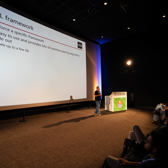Microsoft Power Apps and Power Automate
UPOWER
4 days
Interested in a private company training? Request it here.
Not ready to book yet? Request an offer here.
PART 1 - Power Platform Overview
Introduction to the Power Platform
The Microsoft Power Platform consists of Power Apps, Power Automate, Power BI, Copilot Studio and Power Pages. These applications are powerful alone, yet together, they can be used to create end-to-end business solutions. In this module we will see how Power Apps and Power Automate fit within this Platform.
Topics:
- Overview of the Microsoft Power Platform
- Overview of Microsoft Dataverse
- Real World Use Cases of the Power Platform
Power Platform Licensing Guide
The licensing for the Power Platform might initially seem complex. This chapter will furnish a comprehensive overview of the licensing system and equip you with all the necessary information to accurately assess potential costs.
Topics:
- Power Apps and Power Automate Licensing Overview
- Included Features by License Type
- Connectors and Connections Overview
- Standard vs Premium Connectors
- Add-ons
PART 2 - Power Apps Canvas Apps
Introduction to Power Apps
In the world of information workers, you will handle information that is stored across various software suites, such as SharePoint, Salesforce, Access databases and more. You would like your end-users to be able to browse and/or modify this data in a user-friendly and preferably mobile manner. Microsoft Power Apps enables you, without requiring any development skills, to create these user-friendly applications using your data. Once your design is complete, you can share your apps so others can use and modify them.
Topics:
- Microsoft Power Apps
- Power Platform Environments
- Canvas Apps vs. Model-Driven Apps
- Getting started with Canvas Apps using Templates
- Power Apps on Mobile
- LAB: Getting Started with Canvas Apps
Building Canvas Apps
In this module, we'll explore the capabilities of designing a Power Apps Canvas app using the Power Apps Studio. It also introduces students to Power FX, a low-code formula language that enables app makers to incorporate logic into Power Apps. You will become familiar with connecting to data sources, creating screens, adding controls, bindings, behaviour, and more.
Topics:
- Power Apps Studio
- Creating Canvas Apps with Microsoft Copilot
- Data and API Connections
- Creating Canvas Apps from Data Connection vs. from Scratch
- Screens & Controls
- Galleries
- Forms
- The Power FX Formula Language
- LAB: Customizing a Canvas App
Working with Forms in Canvas Apps
In applications, we often require the ability to view, modify, add, or delete data from external data sources, such as SQL Server or SharePoint. In Canvas Apps, this functionality is achieved using forms. In this module, we will take an in-depth look at the various types of forms available for use in Canvas Apps.
Topics:
- Customizing Edit and Detail Forms
- Saving Form Data to a Data Source
- Data Cards
- Data Card Customizations
- Input Validation
- Hidden Data Cards
- LAB: Working with Forms
Working with Data in Canvas Apps
Most apps rely on one or more data sources. This module covers how to connect and work with them, use local data for temporary storage, and apply best practices for performance and reliability.
Topics:
- Variables and Collections
- Data Source Configuration, Operations & Manipulations
- Handling and Preventing Errors
- Configuring User-Defined Functions and Named Formulas
- Data Source Search, Sort & Refresh
- Data Source Delegation
- Performance Optimizations
- LAB: Build Canvas App on SharePoint Data Source
Configuring and Publishing Canvas Apps
Canvas Apps provide a range of configuration options. Take into account factors like orientation, responsiveness, version control, and more. Once the Canvas App is finalized, you'll likely want to share it with others, embed it within platforms like Microsoft Teams, and monitor its usage. All these facets will be covered in detail within this module.
Topics:
- Canvas Apps Configuration
- Canvas App Responsiveness
- Saving, Sharing and Publishing Apps
- Sharing and Permissions
- Embed a Canvas App in a SharePoint Page & Microsoft Teams
- Canvas App Analytics & Monitoring
- LAB: Publishing and Sharing a Canvas App
PART 3 - Power Automate
Introduction to Power Automate
Power Automate enables the creation of automated business processes, referred to as flows. These processes can be initiated automatically, by a button click, or on a scheduled basis. We harness contextual information from these triggers to execute one or more actions, seamlessly connecting to a variety of data sources such as Outlook, SQL Server, Salesforce, Dynamics 365, and more.
Topics:
- Power Automate Overview
- Power Automate Building Blocks
- Using Connections in Flows
- The Power Automate Mobile App
Building Basic Flows
In this module, you will learn how to construct and customize flows, either by starting from a template or building them from scratch. You will learn how to incorporate and fine-tune actions, oversee connections, and introduce conditions within flows. You will explore the utilization of connectors such as Teams, SharePoint, Exchange, and others.
Topics:
- Building Flows from Scratch
- Automated, Instant & Scheduled Flows
- Building Flows with Microsoft Copilot
- Flow Actions & Connections
- Flow Conditions and Dynamic Content
- Monitoring Flows
- Microsoft 365 Integration
- LAB: Building Flows to Synchronize Files
Popular Connections and Actions
This chapter will furnish you with an overview of engaging connectors and utilities that you can leverage with Power Automate.
Topics:
- List Data and Document Management in SharePoint
- File Management in OneDrive
- File Manipulation in Word and Excel
- User and Group Manipulation in Microsoft 365 and Entra ID
- Data Management in Relational Databases
Modern Approvals with Power Automate
This module will demonstrate how to perform content approvals using Power Automate. Approvals can be employed for various tasks, such as publishing SharePoint documents, planning Teams meetings, or finally obtaining approval for a well-deserved vacation.
Topics:
- Configuring Approvals with Power Automate
- Approval Settings
- Approving and Rejecting Approvals
- Processing the Approval Outcome
- LAB: Approval Flow for Holiday Requests
Power Automate Patterns
Armed with fundamental knowledge and available coding skills, we can elevate the sophistication of our Power Automate flows. This chapter will present practical scenarios and advanced patterns that can be applied in your design.
Topics:
- Advanced Trigger and Action Configurations
- HTTP Actions to Call APIs or other Flows
- Variables, Collections and Data Operations
- Conditions, Parallelism and Loops
- Error Handling
- Limitations
Workflow Definition Language
You can construct impressive flows through the user interface of Microsoft Power Automate. This interface is constructed on the foundation of the Workflow Definition Language. In this module, we will cover the fundamentals of this language and delve into various possibilities for enhancing flows using it.
Topics:
- Introduction to the Workflow Definition Language
- Expressions, Operators and Functions
- Using Expressions in Flows
- LAB: Using Patterns and the Workflow Definition Language
Flow Permissions & Sharing
In this module, you will discover best practices for sharing and permissions related to Flows created within your company. You will gain an understanding of the impact of sharing and the various available sharing permissions.
- Sharing a Flow
- Co-Ownership
- Flow Permissions
- Shared Flow Connections & Credentials
- Run Only Users and Connections
PART 4 - Power Platform Integrations
SharePoint Form Customization
SharePoint is frequently employed as a data source within organizations. Similar to how InfoPath was utilized for customizing SharePoint Forms on SharePoint Server, Power Apps Canvas Apps serve the same role in SharePoint Online. This chapter will guide you through the process of customizing forms for SharePoint lists or libraries.
Topics:
- Customizing a SharePoint Form
- SharePoint Integration Control
- Differentiate Your Form Based on Mode: View, Edit, or New
- Adding Behaviour with Controls
- Wide Screen SharePoint Forms
- LAB: Customizing a SharePoint List Form
Power Platform Integrations
Power Apps and Power Automate are distinct products, yet they can also be seamlessly integrated with each other. This module will demonstrate how you can utilize Power Automate to enhance your Power Apps and vice versa.
Topics:
- Bundling Apps and Flows in Solutions
- Trigger a Flow from a Canvas App
- Open a Canvas App from a Flow Notification
- Power BI & Copilot Studio Integrations
- LAB: Combining a Canvas App with a Power Automate Flow
Microsoft Power Apps and Microsoft Power Automate are integral components of Microsoft's Power Platform, enabling citizen developers to create robust applications and automations using a low-code approach. Power Apps empowers us to construct interactive mobile applications, while Power Automate facilitates the automation of business processes including approvals, synchronization, and more. Throughout this course, you will acquire the skills to construct Power Apps Canvas Apps and implement Power Automate processes that integrate seamlessly with your data. For those interested in developing Power Apps Model-Driven Apps, we recommend exploring the course Building Model-Driven Apps on the Power Platform.
This course targets developers, architects, power users, content managers, business analysts and many more who want to learn how to quickly and easily:
- Build (mobile) applications and forms with Microsoft Power Apps Canvas Apps with no or low-code development
- Build automations in an IFTTT (If This Then That) way using Microsoft Power Automate
No prior knowledge of Power Apps or Power Automate, nor development skills are required.







